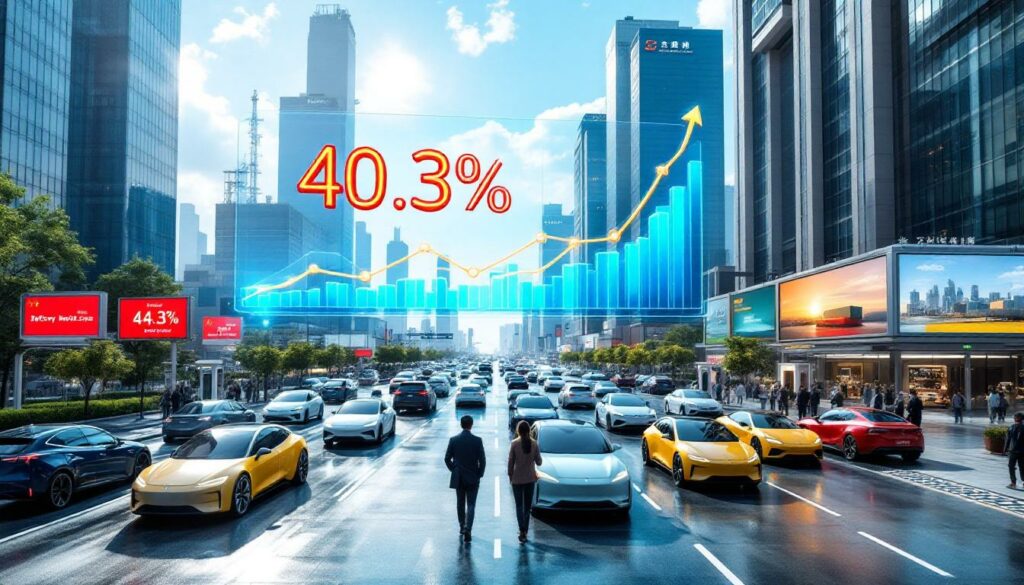China's NEV Market Soars: 40.3% Growth in H1 2025 Sales
China's new energy vehicle (NEV) market has demonstrated remarkable momentum in the first half of 2025, with sales reaching an impressive 6.937 million units. This represents a substantial year-over-year growth of 40.3%, according to data released by the China Association of Automobile Manufacturers (CAAM). The production side shows even stronger performance, with 6.968 million NEV units manufactured during this period—a 41.4% increase compared to H1 2024.
Perhaps most significantly, NEVs now account for 44.3% of all new vehicle sales in China, highlighting the accelerating transformation of the country's automotive landscape. This near-majority market share represents a critical tipping point in China's transition away from traditional combustion vehicles.
"Domestic market improvements driven by the continuing effectiveness of the trade-in policy contributed to over 10% year-over-year growth in the overall automotive sector, providing strong support for market expansion," noted a CAAM official in a recent statement.
Policy Support Driving Adoption
The strong NEV performance can be largely attributed to Beijing's strategic policy initiatives. Government trade-in programs have been particularly effective, encouraging consumers to replace older, less efficient vehicles with modern NEVs. These policies provide financial incentives that make the transition to electric vehicles more affordable for average consumers.
Industry analysts note that these incentives have created a virtuous cycle: as more consumers adopt NEVs, production scales increase, driving down manufacturing costs and making vehicles more affordable even without subsidies. This has allowed Chinese manufacturers to offer increasingly competitive models across various price points.
The government's commitment to large-scale equipment upgrades and consumer goods trade-in programs is expected to continue through the remainder of 2025, maintaining strong momentum in the NEV sector.
How Are Chinese NEV Exports Performing?
Chinese automotive exports have shown remarkable strength in the first half of 2025, with total vehicle exports reaching 3.083 million units—a 10.4% increase compared to the same period last year. What's particularly noteworthy is the performance of NEV exports, which have surged to 1.06 million units, marking a dramatic 75.2% year-over-year increase.
This exceptional growth in NEV exports demonstrates China's increasing dominance in global electric vehicle markets. While domestic sales remain the primary driver of growth, the international expansion represents a strategic priority for major Chinese manufacturers looking to establish global footprints.
Battery Exports Supporting Global Expansion
The export success extends well beyond vehicles to include power batteries and related technologies. According to the China Industrial Innovation Alliance for Power Battery, the country's cumulative exports of power and other batteries reached 127.3 GWh in the first half of 2025, representing a 56.8% year-over-year increase.
Breaking down these figures:
- Power battery exports reached 81.6 GWh, up 26.5% year-over-year
- Other battery exports surged to 45.6 GWh, up a remarkable 174.6% year-over-year
In June alone, China exported 24.4 GWh of batteries, up 27.9% month-on-month and 22.5% year-over-year. Power batteries accounted for 65% of these exports (15.8 GWh), while other batteries made up the remaining 35% (8.5 GWh).
This battery export success underscores China's growing role as the global battery supplier, providing crucial components not just for electric vehicles but also for energy storage solutions worldwide. Chinese battery technology is increasingly seen as competitive with offerings from traditional leaders like Japan and South Korea.
What Challenges Is the NEV Market Facing?
Despite the strong sales figures, there are signs of potential market pressures on the horizon. According to the China Automobile Dealers Association (CADA), the auto dealer inventory coefficient reached 1.42 in June 2025, representing a 2.9% month-on-month increase and a 1.4% year-over-year growth.
The inventory coefficient—which measures the ratio of inventory to sales—provides crucial insight into market health. While the current level remains below the warning threshold, it significantly exceeds the reasonable range (typically 0.8-1.2), suggesting potential oversupply concerns if current trends continue.
Inventory Buildup Signals Potential Challenges
Based on CADA Passenger Vehicle Branch statistics projecting terminal sales of 2.084 million units in June, the total month-end inventory for auto dealers was estimated at approximately 2.95 million units. This inventory buildup could signal challenges ahead if consumer demand doesn't keep pace with production.
The inventory pressure appears to be a natural consequence of the industry's rapid expansion. As manufacturers race to capture market share in the booming NEV sector, some may be overestimating short-term demand. This could potentially lead to price competition if the situation isn't carefully managed.
Industry analysts suggest that manufacturers may need to adjust production schedules in the coming months to bring inventory levels back into balance. Some dealers have already reported increasing promotional activities to move existing stock, which could impact profit margins if widespread discounting becomes necessary.
How Are Regional Policies Supporting NEV Growth?
Regional governments across China are implementing targeted policies to accelerate NEV adoption, with Beijing leading the charge through innovative approaches that address both new and used vehicle markets.
Beijing's Strategic Action Plan
The Beijing Municipal People's Government has issued a "Special Action Plan for Deepening Reform to Boost Consumption," which includes several provisions specifically aimed at improving the automotive consumption ecosystem. This comprehensive approach recognizes that NEV growth requires supporting infrastructure beyond just vehicle manufacturing.
Key measures in Beijing's plan include:
- Optimizing passenger vehicle quota allocation to better meet household vehicle demands
- Nurturing used car business entities to create a healthy secondary market for NEVs
- Implementing convenience measures like "reverse invoicing" and cross-regional transaction registration for used car sales
- Enhancing information sharing across the automotive sector
- Supporting third-party used car information query platforms to increase transparency
- Expanding aftermarket consumption sectors including vehicle modification, leasing, racing events, and RV camping
The "reverse invoicing" system represents a particularly innovative approach to used car sales. This mechanism allows sellers to receive invoices from buyers rather than the traditional opposite flow, streamlining the tax and registration process for cross-regional transactions.
Regional NEV Competition Initiative
Beyond regulatory changes, Beijing is also taking a more direct approach to stimulating consumer interest. The city is organizing a series of NEV competitions within the Beijing-Tianjin-Hebei region specifically designed to stimulate consumption vitality.
These events serve multiple purposes: showcasing the latest NEV technology, allowing consumers hands-on experience with various models, and creating excitement around electric mobility. By coordinating these efforts across the metropolitan region, Beijing demonstrates a commitment to regional cooperation in promoting sustainable transportation.
Industry observers note that these types of engagement initiatives are particularly effective at addressing consumer hesitations around NEV adoption, such as range anxiety or charging concerns. By creating positive associations through competitions and showcases, Beijing is taking a holistic approach to market development.
What's Happening in China's Battery Technology Sector?
China's battery technology sector is experiencing dynamic development on two fronts: rapidly growing exports and significant progress in next-generation solid-state battery technology.
Power Battery Export Performance
China's battery export market has shown remarkable growth in 2025. In June alone, China exported 24.4 GWh of power and other batteries combined, up 27.9% month-on-month and 22.5% year-over-year. This performance reflects China's increasingly dominant position in global battery supply chains.
The export breakdown reveals interesting patterns:
- Power battery exports reached 15.8 GWh (65.0% of total exports), up 17.1% month-on-month and 16.6% year-over-year
- Other battery exports reached 8.5 GWh (35.0% of total exports), up 54.7% month-on-month and 35.2% year-over-year
The stronger growth in "other batteries" suggests diversification beyond automotive applications, potentially including energy storage systems for renewable power and consumer electronics.
Solid-State Battery Development Progress
Several Chinese companies are making significant progress in solid-state battery technology—widely considered the next frontier in energy storage. Unlike conventional lithium-ion batteries with liquid electrolytes, solid-state batteries use solid electrolytes that promise higher energy density, faster charging, and improved safety.
Notable developments include:
-
Hongxing Development has reported that downstream solid-state battery companies are purchasing their manganese products for battery performance validation. The company maintains production capacities of 30,000 metric tons per year for both electrolytic manganese dioxide (EMD) and high-purity manganese sulfate. They have also completed pilot production of Mn3O4 but haven't yet commercialized it.
-
Derui Lithium Battery is accelerating the final acceptance of new capacity construction, with an initial focus on lithium-manganese and lithium-iron primary batteries. These technologies may serve as stepping stones toward advanced solid-state designs.
-
Xi'an High Voltage Institute is developing specialized solid-state battery detection capabilities, addressing one of the key challenges in bringing this technology to market.
These developments highlight China's comprehensive approach to battery innovation, spanning the entire value chain from raw materials to testing infrastructure. While solid-state batteries aren't yet in mass production, these initiatives suggest China is positioning itself to lead in this next-generation technology, particularly through battery recycling breakthrough innovations.
What's the Outlook for China's NEV Market in H2 2025?
The outlook for China's NEV market in the second half of 2025 remains broadly positive, though with some potential headwinds that will require careful navigation by industry players.
Continued Policy Support
Looking forward to the second half of 2025, government programs supporting large-scale equipment upgrades and consumer goods trade-ins will continue their orderly implementation. A CAAM official noted that these policies are expected to "sustain automobile consumption growth and ensure healthy industry operations."
The consistent policy environment provides manufacturers and consumers with the confidence needed for long-term planning, which is particularly important in the rapidly evolving NEV sector. Additionally, the regional initiatives seen in places like Beijing are likely to be adopted by other provincial governments, creating a nationwide ecosystem supportive of NEV growth.
Product Innovation Driving Growth
Industry analysts anticipate that richer new product offerings from enterprises will further stimulate market demand in H2 2025. Chinese manufacturers continue to introduce vehicles with improved range, faster charging capabilities, and enhanced connectivity features—all at increasingly competitive price points.
The combination of policy support and product innovation is expected to maintain the strong growth trajectory for NEVs in China throughout 2025. The increasing variety of models across different market segments ensures that consumers have options regardless of budget or specific needs. Furthermore, the evolving battery metals investment landscape is creating additional momentum in the supply chain.
Navigating Potential Market Challenges
Despite the positive outlook, the rising inventory coefficient suggests potential challenges ahead. Manufacturers and dealers may need to carefully manage production and pricing strategies to maintain market balance and prevent oversupply issues from dampening the sector's growth momentum.
If inventory levels continue to rise, some analysts predict we may see more aggressive pricing strategies in the latter part of 2025. This could benefit consumers in the short term but might put pressure on smaller manufacturers with less financial flexibility.
The industry will also need to address the uneven distribution of charging infrastructure, particularly in smaller cities and rural areas. While tier-one cities have extensive charging networks, expansion into broader markets will require significant investment in charging solutions. The ongoing critical minerals energy transition will play a key role in resolving these challenges.
FAQs About China's NEV Market Growth
What percentage of China's new vehicle sales are NEVs?
As of the first half of 2025, NEVs account for 44.3% of total new vehicle sales in China, demonstrating the significant market penetration of electric and alternative fuel vehicles. This represents a major milestone in China's transition to sustainable transportation.
How much have China's NEV exports grown in 2025?
China's NEV exports have surged by 75.2% year-over-year in the first half of 2025, reaching 1.06 million units shipped overseas. This dramatic growth reflects the increasing global demand for Chinese electric vehicles, which offer competitive pricing and advanced technology.
What is driving the growth in China's NEV market?
The growth in China's NEV sales in H1 is primarily driven by three factors: government policies supporting trade-ins and upgrades, continuous product innovation from manufacturers, and increasing consumer acceptance of electric vehicles. The policy environment, in particular, has created favorable conditions for both manufacturers and consumers.
What challenges might affect China's NEV market in the near future?
Rising inventory levels, with the dealer inventory coefficient reaching 1.42 in June 2025, suggest potential market pressures that could affect pricing and profitability if not carefully managed. Additionally, charging infrastructure expansion in smaller cities remains a challenge for broader market penetration.
How is China's battery export market performing?
China's battery export market is showing robust growth, with cumulative exports of power and other batteries reaching 127.3 GWh in H1 2025, representing a 56.8% year-over-year increase. Power batteries account for approximately 64% of these exports, while other battery types are growing even faster from a smaller base.
Further Exploration
The continued expansion of China's NEV market represents one of the most significant transformations in global automotive history. As the world's largest automotive market rapidly shifts to electric mobility, the implications extend far beyond China's borders—affecting global supply chains, energy markets, and climate initiatives.
For industry participants and observers, staying current with these developments is essential. Regional policy initiatives, technology breakthroughs in areas like solid-state batteries, and evolving consumer preferences will all shape the trajectory of this market through 2025 and beyond.
The balance between growth aspirations and market realities will be particularly important to monitor in the coming months. While the overall direction remains clear—continued expansion of NEV market share—the pace and specific contours of that growth will depend on how effectively manufacturers, dealers, and policymakers address emerging challenges like inventory management.
Recent global lithium insights suggest that raw material supply chains will continue to evolve rapidly, with implications for cost structures and competitive positioning. Additionally, ongoing US-China trade impacts continue to influence market dynamics, particularly for export-oriented manufacturers.
According to Chinese automotive market data, leading manufacturers like BYD and SAIC have already surpassed 2 million units in sales during H1, demonstrating the massive scale of China's transition to electric mobility.
Disclaimer: This analysis is based on data as of July 2025 and represents the market situation at that time. Future developments may diverge from current expectations due to policy changes, technological breakthroughs, or shifts in market dynamics.
Want to Profit from the Next Big Mineral Discovery?
Discovery Alert's proprietary Discovery IQ model instantly notifies investors of significant ASX mineral discoveries, turning complex data into actionable insights for both short-term traders and long-term investors. Explore why historic discoveries can generate substantial returns by visiting Discovery Alert's dedicated discoveries page today.




